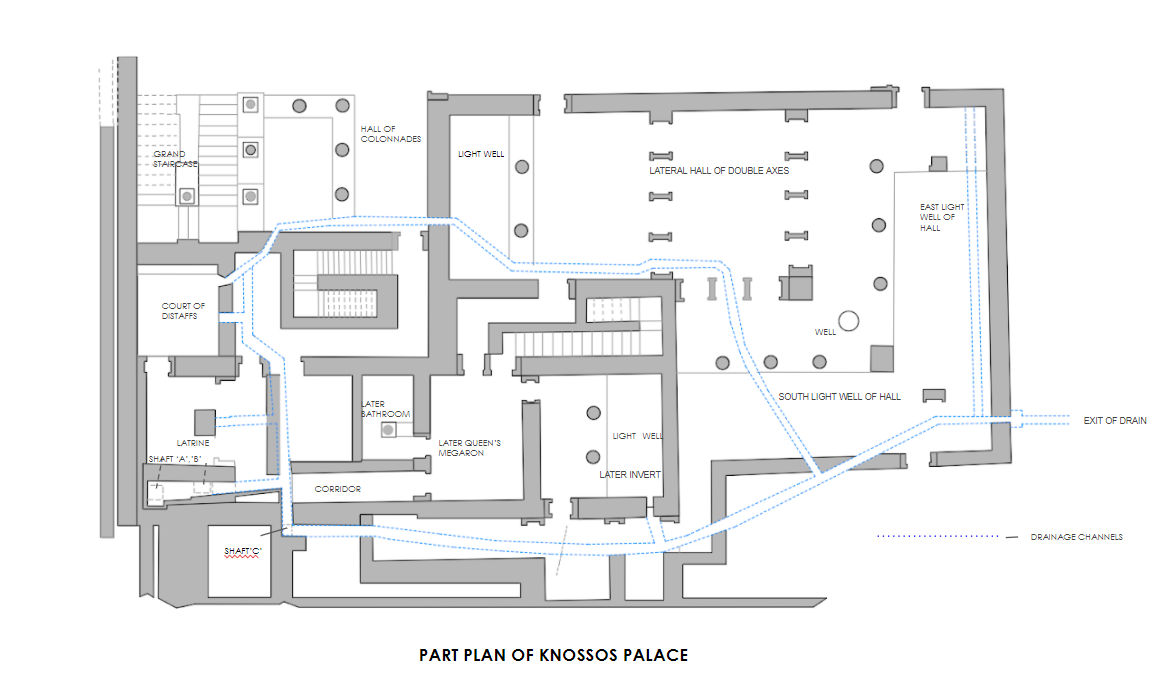WATER MANAGEMENT SYSTEMS AT THE KNOSSOS PALACE GREECE
THE KNOSSOS PALACE, GREECE
INTRODUCTION
- The PALACE OF KNOSSOS is located in Crete city, in Greece.
- It was a major part of the MINOAN CIVILISATION
- The Palace had three water management systems -water storage, water harvesting, drainage and sewage system.
- Long-distance systems for transporting water to the urban areas had been developed since prehistoric times due to the mountainous terrain of Crete city.
- Conduits carried water from mountain springs to Palaces and cities ,utilizing a combination of open channels and closed pipes in Knossos .
- The main source of water supply at the palace of Knossos, initially, was the spring of Mavrokolymbos, a pure limestone spring located approximately 500 m southwest of the palace.
- As population increased ,other water sources developed from further distances and incorporated into the water supply system.
- A conduit made of terracotta was used to convey water from a water spring on the Gypsadhes hill to Knossos and was later extended to carry water from Mt. Juctas 10 km away.
WATER STORAGE
- Wells and Pots are used for the storage of water.
- The Wells were assembled with tightening mud bricks to have a stronger life to last for centuries.
- The pots were made up of ceramic .
- The Materials helps to keep the water cool.
- Shape and depth varied with static problems and soil characteristics and with depth of groundwater in the city’s plateau.
- The end part of each well, dug upto impermeable mark, was used as a water storage tank.
- In order to guarantee the availability of water even in times of drought when the water table was lowered to the boundary of river gravel.
RAINWATER HARVESTING
- The rainwater flows through the different levels and channels throughout the palace and finally meets the main water storage pit.
- This stored water is further used for day-today activities for flushing purpose, watering plants, etc.
- The channels then finally meet the main water storage pit through one of the last main channel.
WATER SUPPLY AQUEDUCTS
- Terracotta pipes were used for a variety of purposes. They could convey either storm water collected from roofs, waste water, or fresh water from nearby springs and aqueducts.
- They then conveyed this water to cistern systems, palaces, sewage and drainage systems.
- Minoan aqueducts were of two basic types: the open/natural gravity flow system and the closed/pressurized pipe system.
- The open channels were typically rectangular stone and/or U-shaped and the closed were terracotta units.
- The closed system implies a practical knowledge of the hydraulic principle that water seeks its own level also known as the principle of communicating vessels.
- The water first descended and then ascended through a bridge with an estimated inclination rate of 5% suggesting an application of the principle of communicating vessels.
DRAINAGE AND SEWER SYSTEM
The Knossos Palace which lies on a hilly area occasionally receives large amounts of precipitation, hence development of drainage system was necessary.
•An open channel sewerage and drainage system was lined up by the means of mud and clay.
•System drains also included rainwater from the roof, which may have been connected with toilets on the upper floors.
•Manholes were constructed for maintenance purpose, for the locations where the channels were completely closed for long distances.
•The sewers, then, were large enough to permit men to enter them for cleaning or maintenance; in fact, manholes were provided for this purpose.
•There were openings located at intervals for ventilation.
•The sewerage system which was constructed with mud bricks, were highly functional and more reliable compared to modern times.
The water from the pit is used for the purpose of bathing, then the water from the bathing platform enters the mini-channels and then the drained water falls into the bigger channels called as soak pits and they further join the main channel further. .
PUBLIC TOILETS
SECTION OF THE PUBLIC TOILET
- These are the public toilets used by the common people.
- The type of toilets are called as ‘flush toilets’ and these are the first kind of flushing toilets
- There are channels for the flushing purpose in the middle of the public toilet area
- There are ceramic tubs for the storage of water used for the purpose of flushing
- https://www.thecivilengineer.org
- https://www.researchgate.net
- https://www.mdpi.com
- https://www.slideshare.net/
- www.wikipedia.com
- www.pinterset.com






Comments
Post a Comment